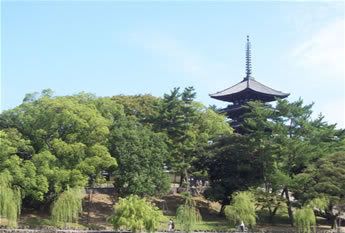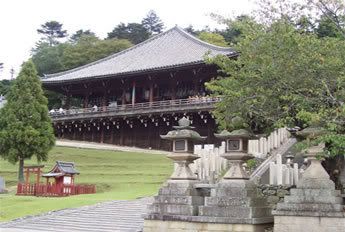Kofuku-ji temple pagoda peeking over the trees
The second most popular tourist attraction in the Kansai region (after Kyoto) is Nara. In early Japanese history the country had no permanent capital city. With the death of each Emporer the capital was moved accordingly. Only the influence of the new Buddhist religion spurred reforms that led to the establishment of the first permanent capital in 710 - and the place they chose was Nara. However, only 75yrs later a lowly priest managed to seduce the Empress, so it was decided to move the capital again - to put the female royals out of reach of the randy clergy. So Nara lost out to Kyoto, which became the seat of power until Tokugawa Ieyasu moved it to Edo, as I mentioned previously.
Kazuko and me at Kofuku-ji
In Nara we hired a volunteer 'Goodwill Guide' - members of the tourist information service that act as free guides for tourists. Ours was a kindly middle-aged lady called Kazuko, whom we had arranged to meet at the station. She spoke excellent English, and it turned out had visited the UK twice so she could specifically go to Edinburgh - albeit because she was a mad-keen fan of Harry Potter, and wanted to see where they were written. I tried to be as polite as possible about this - I can't stand that bloody wizard. Still, she knew a reasonable amount about Edinburgh so we talked about that for a while.
Nara's main historic sights (and there are plenty) are located in a large park at the foot of a hill. Having Kazuko with us was great, as she explained in detail about everything we saw. The hill, Wakakusa-yama, is ceremonially burned every January to purify the soil - but Kazuko also said it was so the monks can`t hide up in the bushes and indulge in 'unholy deeds'. It seems their reputation has remained over the centuries. The park is home to over a thousand deer - thought to be the messengers of the Gods and therefore devine. They wander around nonchalantly eating leaves and chasing tourists foolish enough to buy 'deer crackers' for Y100.
Todai-ji - the largest wooden building in the world
We walked through the Kofuku-ji temple enclosure, most of which had been destroyed by fire over the years - but there was one remaining small, dark wooden building dating from the 8th Century. At the other end of the scale, size-wise, is the astonishing Todai-ji - the largest wooden building in the world. The current one, built in 1709, is actually one-third smaller than it used to be. It`s hard to get across the sheer scale of the place - it was just incredible. Inside is one of the largest bronze statues in the world, the Great Buddha - or Daibutsu. Kazuko explained all about the history and religious meanings behind the statue which was 16m high and weighed almost 450 tons. To one side of the statue is a small hole in one of the massive wooden supporting pillars. Apparently the same scale as one of the Buddha`s nostrils, if you can fit through you will achieve true enlightenment. Predictably, it was the kids who were going for it - I didn`t fancy my chances. I guess I`ll have to become enlightened by some other means.
Nigatsu-do, and the flaming balcony
We finished the walk by stopping at a large, blackened, two-story building called Nigatsu-do (February's Hall). Every March (not February), the monks go through an initiation process where they carry enormous flaming torches around the city. These things are the size of small trees, and are hauled from Todai-ji to Nigatsu-do. Here they climb up to the balcony (causing the roof of the wooden staircase to blacken) and wave the burning torches off the verandah. Apparently firemen are on hand - but incredibly people gather underneath the temple and wait for the flames - if you get dripped on by embers you'll have good health for the rest of the year, although probably not immediately. I asked Kazuko if the temple had ever caught fire as a result. "Oh yes," she replied cheerfully. "But they rebuilt it, of course".